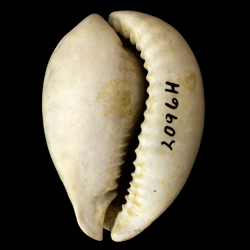
Cypraeidae

- Phylum: Mollusca
- Class: Gastropoda
- Order: Littorinimorpha
- Family: Cypraeidae
Overview
Common name: Cowries
Key morphological features: The Cypraeidae are small to large gastropods (up to ~190mm) with often colorful, smooth, ovate shells that are dorsally inflated and ventrally flattened. The body whorl in most species covers the spire, producing an involute appearance. Exteriorly, Cypraeid shells are smooth and shiny due to deposition of lamellar calcium carbonate by the mantle, which in living individuals extends to cover the entire shell. The aperture is very narrow and extends across the entire anteroposterior axis of the shell. Each side of the aperture is serrated in appearance, featuring small but prominent teeth. Source: Davies, A.M. 1971. Tertiary Faunas Vol. 1, second edition. New York: American Elsevier Publishing Company, Inc. 571 pp.; Tunnell Jr., J.W., Andrews, J., Barrera, N.C., Moretzsohn, F. 2010. Encyclopedia of Texas Seashells. College Station: Texas A&M University Press. 512 pp.; Moretzsohn (2014).
Geological range: Upper Jurassic to Recent (Davies, 1971).
Geographic distribution: A distributional map for modern Cypraeidae may be accessed from OBIS. A distributional map for ancient Cypraeidae may be accessed from the Paleobiology Database.
Diversity: There are 251 recognized living species of Cypraeidae and 50 genera (WoRMS database, unvetted). The Paleobiology Database recognizes 77 fossil genera and 606 fossil species of Cypraeidae (unvetted).
Paleoecology: The Cypraeidae are epifaunal, herbivorous, marine gastropods that live mostly on hard substrates, such as coral reefs. They can be found in tropical waters worldwide at depths ranging from shallow to ~700m. Source: Tunnell et al. (2010); Moretzsohn (2014).
Phylogenetic status: Unknown.
